My gardening great grandfather George Cook swore that garlic was the key to a long life (and he lived to 108), he may have been on to something; garlic contains vitamins C and B6, manganese and antioxidants like allicin and selenium. Throughout the ages garlic has been used to prevent almost every ailment known to man and woman, from circulatory disorders to cancer. I have translated medieval garlic growing and medicinal uses from the Ruralia Commoda, you can read those here.
MrsGrow is part Italian so we eat our fair share of Italian dishes all of which require garlic. I would say that garlic is one of the most cost-beneficial crops that I grow at the allotment. My preferred variety for planting is ‘Early Purple Wight’ which I find does well on clay, has both a wonderful flavour and odour, and stores through until the following year after harvesting.
When to Sow Garlic
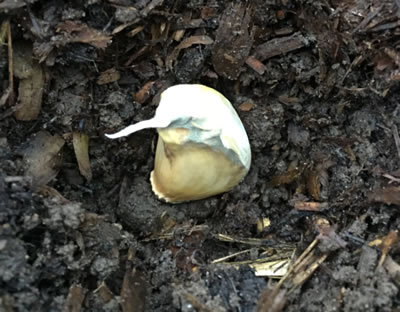
A Garlic Clove Ready for Covering
I spent several years sowing garlic in the Autumn for harvest the following summer. This seems to be the general advice most gardeners and allotment holders are given. People are under the impression that garlic needs a deep cold spell in order for the cloves to form. However, I’ve done a lot of reading and that is not accurate. According to recent scientific research garlic cloves exposed to a cold spell (of 5C and less) grow much faster when planted but with a smaller yield at harvest time. Conversely room temperature stored garlic takes FIFTY days longer to reach maturity but the bulbs are bigger AND the cloves still form perfectly.
I think what has probably happened over the years is that neighbouring gardeners have compared their garlic bulbs at the same time in summer, found that the Autumn or Winter sown garlic is more well developed, and then assumed the cold exposure is linked to that clove formation. In truth the cold spell is only linked to the speed of the clove formation, but a patient veg grower who waits 2 months longer will get a bigger harvest and the cloves will still be separated.
- Sow garlic in the Autumn if you want fast growing garlic, ready in early Summer.
- Sow garlic in Winter of you want fast growing garlic, ready in early to mid Summer.
- Sow garlic in April if you want slower growing garlic with bigger cloves, ready in early Autumn.
As well as noting that the cold spell shortened the growth period, scientists also found an increased propensity for cold spell exposed garlic to bolt. So perhaps your best bet for growing garlic might actually be an April sowing. Personally I still sow garlic in January because I want my garlic in the summer and I’ve found it only delays harvest by 2 weeks vs a November sowing.
Where to Sow Garlic
Garlic grows best in full sun and does not appreciate soggy conditions. My allotment has heavy clay soil and I’ve found that the cloves can get rot quite easily because clay is slower to drain than sand. I have reduced this rot problem by sowing in January (which reduces exposure to winter wetness) AND by making that initial January sowing in pots (in an unheated greenhouse). The garlic grows well in pots and then once we reach March I plant each one out at the allotment, taking care not to disturb the roots. Watering the pot first is a good idea to keep the soil on the roots. I do the same with my onion sets, it makes it more difficult for the local rooks to come and lift them all back out of the ground.
You can plant garlic in rows or I find it quite helpful to sow into the corners of raised beds. There are two reasons why I prefer this technique:
- Space – the corners of my beds are often empty, sowing into the corners doesn’t prevent me getting started with main crops in Spring the following year. The garlic will be gone in early summer anyway if main crops expand to edges and corners.
- Pests & Diseases – planting one crop variety in a single location makes it easier for pests and diseases to spread throughout. I like to make life more difficult for rust or wire worm (which aren’t just a potato issue for me). The odour of garlic is also known to deter some pests (including slugs and snails) consequently my logic is that spreading the plants out also spreads the odour to dissuade a visit to a courgette plant or lettuce later in the Spring and Summer.
- Garlic Rust
- Corner Planting Method
When to Harvest Garlic
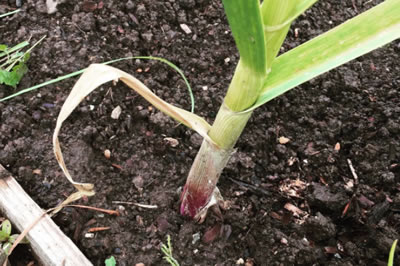
Yellow Leaves – Harvest Indicators
Garlic doesn’t need much attention after sowing (perhaps one liquid compost feed in late Spring) and is generally ready for harvesting when the leaves begin to turn yellow or brown and dry out. If you have sown garlic in the previous Autumn then June is typically the best time for harvesting in the South of England. There isn’t an exact harvest time indicator just keep in mind that if you leave the garlic until all the leaves have turned yellow then the cloves may not keep as well. If the plants are still quite green with only a hint of yellow on the tips it may be too early.
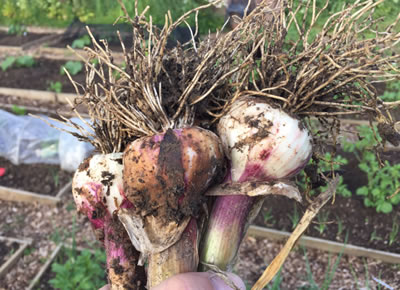
Garlic Bulbs
If in doubt ‘below ground investigation’ is the best method – have a little dig down around a bulb with your fingers to look at the sides and determine whether it is good to harvest. For the past three years I have harvested garlic around the 5th or 6th of June. This year a sudden cold spell and continued heavy downpours persuaded me to harvest yellowing plants – I didn’t want to risk white rot developing on the bulbs.
Storing Garlic
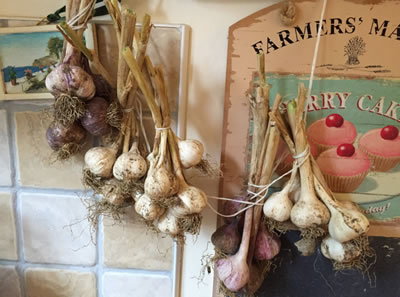
Dried Garlic in our Kitchen
Once harvested lay garlic bulbs with their stems intact on their sides somewhere warm and dark – typically I choose a warm garden shed rather than the greenhouse (which can accidentally bake the garlic!). As a rule I tilt the garlic bulb stems slightly downwards at a 10 degree angle raising the bulbs above the stems so that the bulbs dry out and any liquid is drained away from them. After a fortnight the stems are dried out, at which point I cut, tidy and tie them together for location in the kitchen. Easy access for MrsGrow to use in Italian meatballs or Spaghetti!

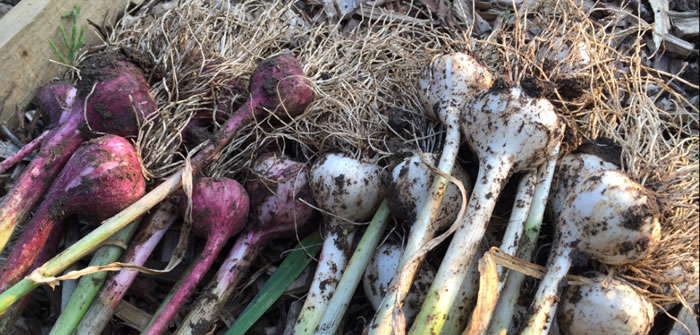
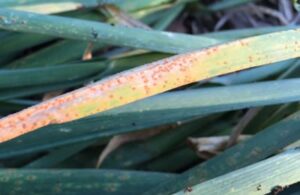
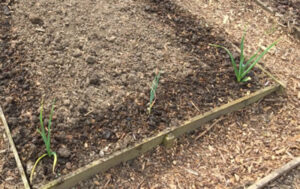
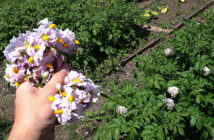
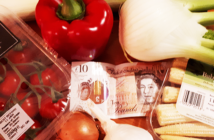
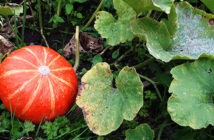
1 Comment
I really enjoyed finding your site and your approach. I’ have a no-dig, organic, forget-the myth type garden and am self-sufficient in fruit and veg for approx 7 months (apart from bananas). During the winter I usually have one or two things from the garden/storage each day. I will enjoy consulting your wisdom which is so obviously from experience. So much habit-gardening is passed on without question. Thank you for sharing your knowledge. Julia in Cornwall.